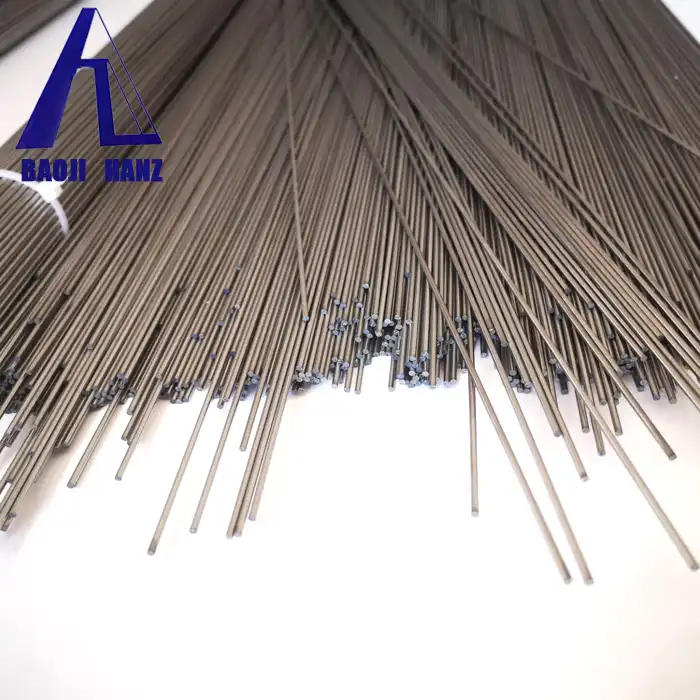What is nitinol wire made from?
2024-07-02 19:27:28
1. How is Nitinol Wire Manufactured?
Nitinol wire is primarily composed of nickel and titanium. It is created through a process called martensitic transformation, where the alloy undergoes a phase change from austenite to martensite when cooled below its transformation temperature. This process gives nitinol its shape memory and superelasticity properties, making it suitable for various medical, engineering, and consumer applications.
2. What Are the Key Properties of Nitinol Wire?
Nitinol exhibits superelasticity and shape memory due to its ability to undergo reversible phase transitions. This means it can return to its original shape after being deformed, a property highly valued in applications such as medical stents, eyeglass frames, and orthodontic wires. Its biocompatibility and resistance to corrosion further enhance its utility in medical devices.
3. What are the Main Applications of Nitinol Wire?
Nitinol wire finds extensive use in biomedical applications, including as vascular stents that can expand and contract within blood vessels. It is also employed in robotics for actuators and in consumer goods like eyeglass frames that can withstand bending without permanent deformation. Additionally, its unique properties make it valuable in industries such as aerospace, where precision and reliability are critical.
In-Depth Exploration of Nitinol Wire
Nitinol, scientifically known as NiTi (Nickel Titanium), is an alloy composed primarily of nickel and titanium. This combination results in a material with remarkable thermal and mechanical properties. The key characteristic of nitinol is its shape memory effect and superelasticity, which are outcomes of its phase transitions between austenite and martensite structures at specific temperatures.
Composition and Manufacturing Process
Nitinol typically consists of approximately 50% nickel and 50% titanium by atomic percentage. The exact composition can vary slightly depending on the desired properties for specific applications. The manufacturing of nitinol involves precise control over alloying elements and heat treatment processes to achieve the desired phase transformations.
Properties of Nitinol Wire
Shape Memory Effect: Nitinol exhibits a unique ability to return to its predetermined shape when heated above its transformation temperature (Af), even after significant deformation. This property makes it ideal for applications where shape memory is critical, such as in medical implants and actuators.
Superelasticity: Nitinol also demonstrates superelastic behavior, allowing it to undergo large deformations (up to 8%) and recover completely upon unloading. This makes it suitable for applications requiring high flexibility and resistance to mechanical fatigue.
Biocompatibility: The alloy's biocompatibility, corrosion resistance, and durability make it widely used in medical devices, including vascular stents, guidewires, and orthodontic appliances.

Applications of Nitinol Wire
Medical Industry: Nitinol is extensively used in the medical field due to its biocompatibility and mechanical properties. It is employed in minimally invasive surgical instruments, dental braces, and various implantable devices.
Consumer Goods: In consumer markets, nitinol is found in items such as eyeglass frames, where its flexibility and shape memory allow for durable and comfortable products.
Aerospace and Robotics: The aerospace and robotics industries utilize nitinol for its lightweight nature and reliable performance in actuators and sensors.
Conclusion
In conclusion, nitinol wire, composed of nickel and titanium, is a versatile material with unique properties that have enabled its widespread adoption in various industries. From healthcare to consumer products and aerospace, its ability to exhibit shape memory and superelasticity continues to drive innovation and improve the functionality of numerous applications.
For further reading on nitinol wire and its applications, refer to the following sources:
-
Johnson, J. A., & Rentschler, M. E. (Eds.). (2019). Shape Memory and Superelastic Alloys: Technologies and Applications. Woodhead Publishing.
-
Pelton, A. R., & Duerig, T. W. (1990). Shape Memory Alloys. Scientific American, 262(5), 74-82.
-
Stöckel, D., Somsen, C., & Neuking, K. (Eds.). (2016). Shape Memory Alloys for Biomedical Applications. Woodhead Publishing.
These resources provide comprehensive insights into the composition, properties, and applications of nitinol, catering to both technical enthusiasts and professionals interested in this remarkable alloy.